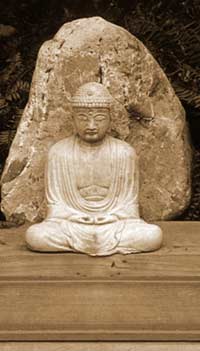| Forest Sangha Newsletter | July 1996 |
|
Upasika News ....How good it is to be in contact with companions on the path. The experience of common aspiration and values, and difficulties is all too rare a treat for some of us.... ..The heart is full of gratitude to the monastic sangha for existing. But it is easy to overlook what lay supporters can offer each other, and to think that the monastery is the only place where we can draw inspiration and insight, where we can be 'spiritual'. Yet, as was pointed out in our small group meeting, the practice in the monastery simply involves things like relating to that to which one is averse, examining it in the light of the Four Noble Truths - and this practice is available to us outside the monastery too! Admittedly it might be easier in the monastery where there is commitment to practice, but of course leadership in the monastery is important and neither that nor the commitment is a 'given'. Nevertheless the general atmosphere of peaceful and wholesome aspiration is undoubtedly beneficial to those who visit. But it can be fragile, for example when senior monks disrobe. Where else might we find support?... |
|
By openly affirmling their commitment, upasikas are making a public statement that is inspiring to others and also encourages them to stick to the practice. |
|
...The importance of local groups was emphasised again and again as we attempt to practise in a culture that is not Buddhist. And even contact with Amaravati can be daunting at first...
Would developing a lay vinaya help?...In considering this, some voiced concern, since there is a variety of social mileus in which lay supporters operate - could there be a lay vinaya that could possibly cater for all? We have to be part of other lay communities: the work-place and family being the most obvious. However the point was made that our vinaya could essentially be simply a reflection on how the Five Precepts might be extended. My hope is for more practicality. I like the idea of an advertisements column for example. My interest is to learn and practise chanting in Pali together, not only for the experience itself, but also as a route in to understanding Pali a little. I am also interested in exploring how lay supporters might set up a network of 'confessors' for each other. (Having heard that this is something done regularly by monks and nuns as a way of 'recharging the batteries.' |
|
Jeffrey Craig Time seemed to fly by, and two hours was just not enough to fully appreciate the different circumstances and challenges of our individual practice. For both upasikas and Monastic Sangha to share together was a deeply nourishing experience. To hear and understand the need and struggle for solitary practice, and also for close intimate friendship was both moving and empowering. ...Ajahn Viradhammo's Dhamma talk on the Saturday night added a tremendous dimension pointing out that Upasikas and Monastics are 'in the soup' and practising together; that we all have knowledge and share similar difficulties and challenges, and that each really needs and can support the other. Bringing the weekend into mind, I have a warm recollection of shared space, of sacred space - the monastics, like us, were invited guests and we were, and are, all part of a wonderful living tradition, 2500 years old, and yet relevant, worthwhile and very precious today.' |
 |
|
Chris Ward ...Sometimes we may wonder whether the Upasika movement is divisive or elitist. In the West we are very suspicious of anything that seems to suggest authority or an elite - we see mainly the negative aspects. Concerns about elitism arise when people are excluded along arbitrary and often prejudiced grounds from joining a group. We can and have avoided this so far by ensuring that the Upasika Community is open to all who wish to be committed to the Triple Gem. But actually life itself is exclusive - we cannot be in two places at once; we cannot be simultaneously both committed to the Triple Gem and also not committed to it. We can be an ordained bhikkhu or a lay person - but not both at the same time. This is obvious, but sometimes forgotten. ...By openly affirmling their commitment, upasikas are making a public statement that is inspiring to others and also encourages them to stick to the practice... ...Being a lay Buddhist means being open to questions about how we can combine family and work responsibilities with Buddhist practice. What are the limits? Do we have to deliberately forsake worldly involvements in order to be enlightened? Are we averse to worldly responsibilities and intent on escaping from these? Listening to Luang Por Sumedho, it is clear that the Forest Sangha Tradition encourages community practice and mindfulness in everyday life. Being mindful washing dishes and moving chairs; noticing our minds when dismantling shrines. ...So perhaps one of the particular challenges for lay Buddhists is in coping with diverse responsibilities without being deluded by them. ...And then there are our desires for comfort and good organisation. We might come expecting that the arrangements will work perfectly, that we will be comfortable warm and happy for the whole time; that we will be inspired by the wonderful people in our discussion groups. When faced with a cold shower, or irritation at another's comments, our feelings of inspiration and universal benevolence can reduce somewhat. Perhaps being mindful of our reactions in these circumstances is where the real practice is... ...I am left with a feeling of community with both lay and ordained Buddhists and much gratitude to all those who made the weekend happen, both behind the scenes, and in more leading roles. Especial thanks to Nick Carrol, who not only led the organisation of the event, but also coped very well with facilitating a shrine room full of unruly Buddhists.’ |